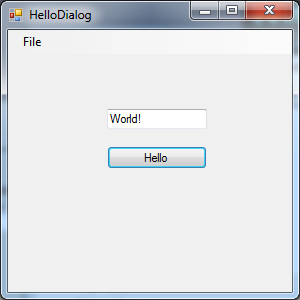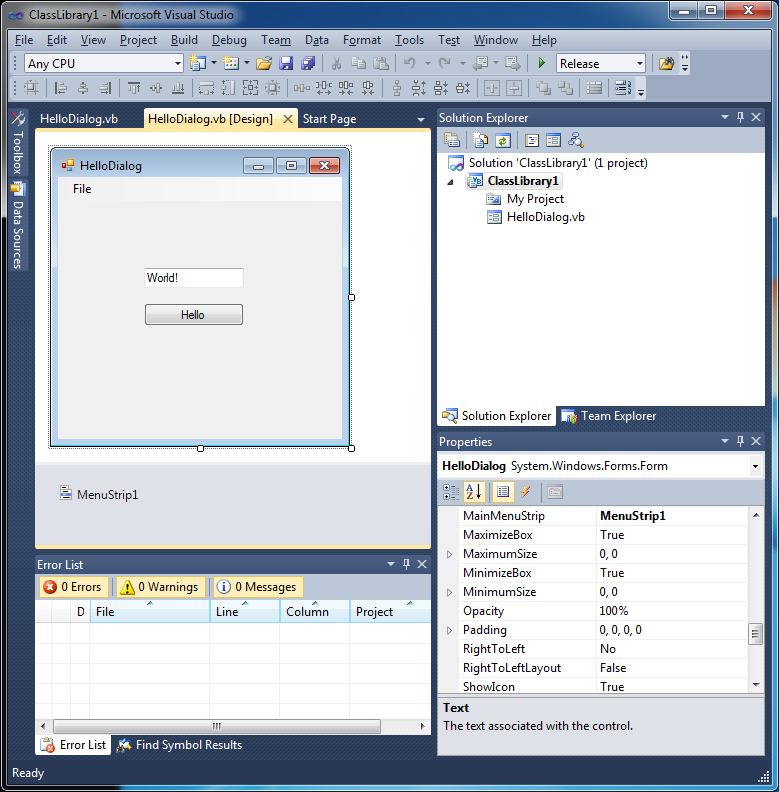Show a WinForm Dialog from your WinWrap Basic Script
WinWrap® Basic is an embedded language control available for .NET/COM 32/64 bit Windows applications. The WinWrap® Basic Component is compatible with VBA, Sax Basic, VB.NET and Visual Basic 6.0 style scripts.
Display custom WinForm Dialogs from WinWrap® Basic scripts. Incorporate any WinForm control. Show custom user interfaces for specific clients.
Use Custom Windows Dialogs with your WinWrap® Basic Application
- Utilize any Windows UI Control
- Works with .NET, WPF, and COM applications
- Dynamically display custom WinForms
- Implement custom user interfaces for specific clients
- Access host application specific extensions
- Requires WinWrap® Basic with WWB-NET scripting option

WinWrap® Basic WinForm HelloWorld! Example
Use Visual Studio or Visual Studio Express to define the visual layout of the desired Winform dialog.

HelloDialog.wwd
- Declare the dialog and .NET framework control variables
- Create the Hello Dialog object and bind to the dialog variables
- Bind the .NET framework control variables to the dialog elements
- Show the WinForm HelloDialog
- Script the desired behavior in the events

'#Language "WWB.NET"
Imports System.Windows.Forms
Imports System.Reflection
' Declare the dialog and .NET framework control variables
Dim WithEvents helloDialog As Form
Dim WithEvents textbox1 As TextBox
Dim WithEvents button1 As Button
Dim WithEvents exitMenuItem As ToolStripMenuItem
Sub Main()
' Create the Hello Dialog object
Dim assemblyPath As String = MacroDir & "ClassLibrary1�inReleaseClassLibrary1.dll"
Dim assemblyClassLibrary1 As Assembly = Assembly.LoadFrom(assemblyPath)
Dim typeHelloDialog As System.Type = assemblyClassLibrary1.GetType("ClassLibrary1.HelloDialog")
Using helloDialogResource As Form = System.Activator.CreateInstance(typeHelloDialog)
helloDialog = helloDialogResource
' Bind to the dialog variables
textbox1 = helloDialog.Controls("TextBox1")
button1 = helloDialog.Controls("Button1")
exitMenuItem = helloDialog.Controls("MenuStrip1").Items("FileToolStripMenuItem").DropDownItems("ExitToolStripMenuItem")
' Show the WinForm HelloDialog
helloDialog.show()
While helloDialog.Visible
Wait 0.1
End While
End Using ' call helloDialogResource.Dispose
End Sub
' Handle the Button1 click event
Private Sub button1_Click(ByVal sender As Object, ByVal e As System.EventArgs) Handles button1.Click
MsgBox(button1.Text & " " & textbox1.Text)
End Sub
' Handle the "Exit MenuItem" click event
Private Sub exitMenuItem_Click(ByVal sender As Object, ByVal e As System.EventArgs) Handles exitMenuItem.Click
helloDialog.Close()
End Sub
Running the HelloDialog.wwd Script

You can download HelloDialog.zip clicking the following link:
WinWrap® Basic Windows Hello Dialog! example.
Then open the HelloDialog.wwd macro with WinWrap® Director. WinWrap® Director is part of the WinWrap® Basic Scripting evaluation product. You can modify the ClassLibrary1.dll which defines the HelloDialog with Visual Studio 2010 or Visual Studio Express.